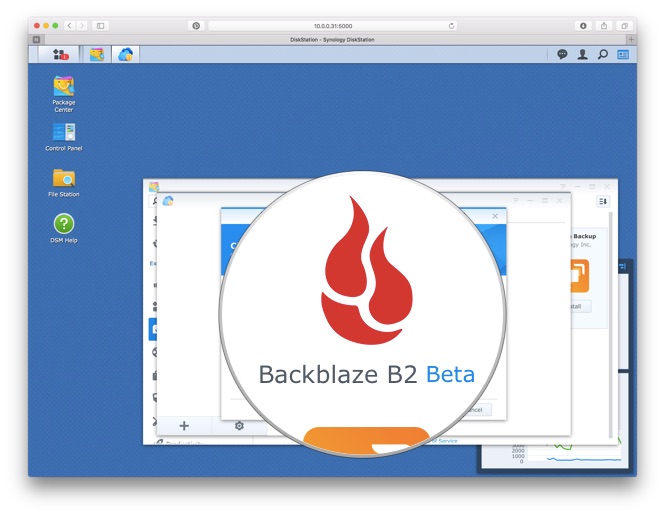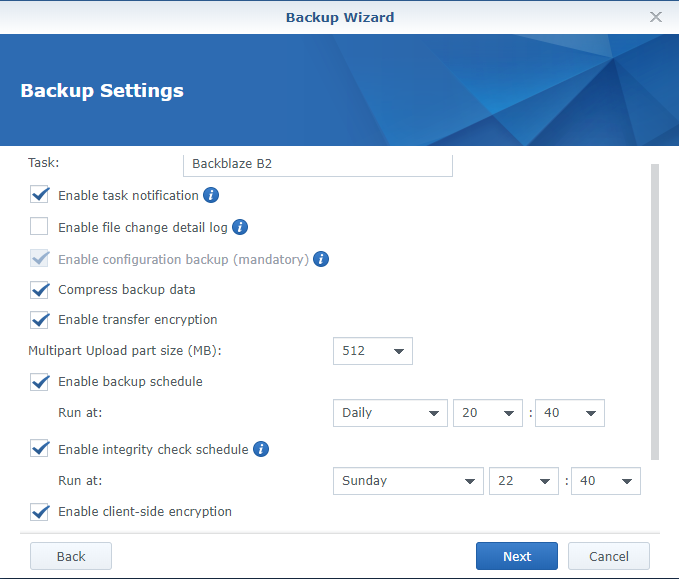
Early in 2016 I published a post on how I setup my Synology NAS to backup to CrashPlan from Code42. It certainly wasn't an out of the box process and involved a lot of behind the scenes hacking on both the Synology and my laptop in order to get it going. It did, however, work well.
Synology’s Hyper Backup allows users to back up various kinds of data (system configurations, shared folders, and applications/packages) on your Synology NAS, manually or by schedule. You can store the backup data in local shared folders, remote servers, and public clouds, like Backblaze B2 with our new S3 API. Bellevue, WA—July 7, 2016—Synology ® Inc. Today announced its top rated file syncing and backup application Cloud Sync now supports B2 Cloud Storage, an increasingly popular and competitively priced cloud storage service from Backblaze. 'Synology is committed to providing a storage platform that is deeply integrated with multiple public cloud services,' said Alex Wang, CEO of Synology. Readily available backups. With a 1-1 mapping between files on-prem and objects in the cloud, all of your data is secure and ready to restore. Long-term retention and 3-2-1 backups of your Veeam data have been simplified and made easily accessible with the joint solution from Backblaze B2 and Tiger Bridge. Explore Quickstart guide.
For a time.
I started to notice a pattern in that, with every iteration of the DSM platform or Java update, the CrashPlan service would just stop. I'd get it going again, but each time, it was not as simple as clicking the Start button next to the Service window. No, it was always far more detailed than that and I started to grow weary. I even went weeks at times without backing up my NAS, and this was not a situation I could tolerate any more.
At the time, when researching backup solutions, I felt disappointed that Backblaze weren't offering any kind of solution for this. I had been using Backblaze for several years on my Mac devices and always found it to be a solid, reliable and unobtrusive piece of software. I've only needed to restore a few items in that time, yet each time the process was quick and easy. This is what I ideally wanted on my NAS.

Well, now I do.
Backblaze now offer a B2 Cloud Storage which links directly to my Synology NAS. Rather than paying a fixed monthly fee, B2 works in a very similar mould to it's cloud storage competitors in that you will pay per GB (currently $0.005 per GB), so working out your appromiate monthly bill is simple.
The best part about this solution is, without question, the ease of setup and subsequent lack of worry. You can 'set it and forget it', just like on your laptop or desktop machine. Backblaze provide an intuitive guide which lays out the steps in a logical, well explained manner.
I'd say more, but once the guide was followed, I haven't had to carry out any more maintenance. It's important to note that this is a Cloud Storage solution for your NAS as opposed to a fully fledged Backup solution. I use this solely for duplicating all of my NAS content to cloud storage. I can then download on any device with an internet connection.
Synology Backblaze B2 Authorization Failed

So quick, so simple, so hassle-free.
That's enough of a selling point for me.
It depends on the volume of data. Running a second Synology unit at another site and mirroring changes (using something approaching the efficiency of rsync) will easily be the most economical beyond 1tb -- an amount typically included for free with just about every Office 365 subscription. It's not ideal however, unless you plan to perform DR to the cloud; that is, restore a failed local instance to a cloud platform. This is because you will be unable to get one tenth of 1tb of data that stored in the cloud in a timely fashion unless it is being restored to an adjacent platform.
Synology Backup Windows
The cool thing about rsync is that the bandwidth use can be near zero as you can do a full mirror once a week but generate a differential file each night and export it to a local drive instead of applying the changes over the internet. That differential file can be used to roll the remote version forward to the time the file was generated. You would only actually apply it to the remote mirror if need be -- testing notwithstanding.
